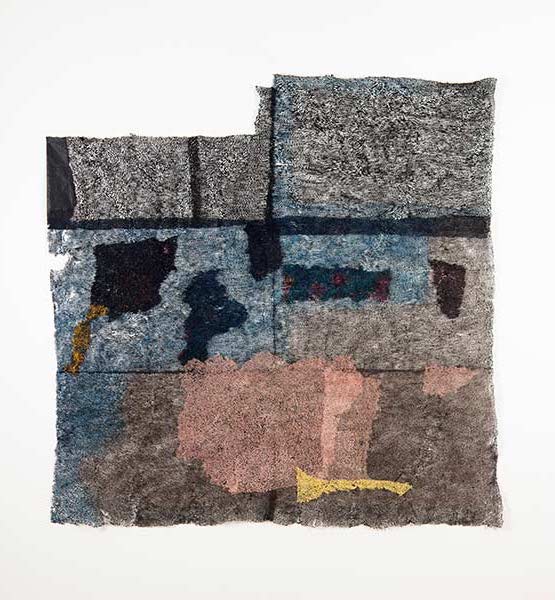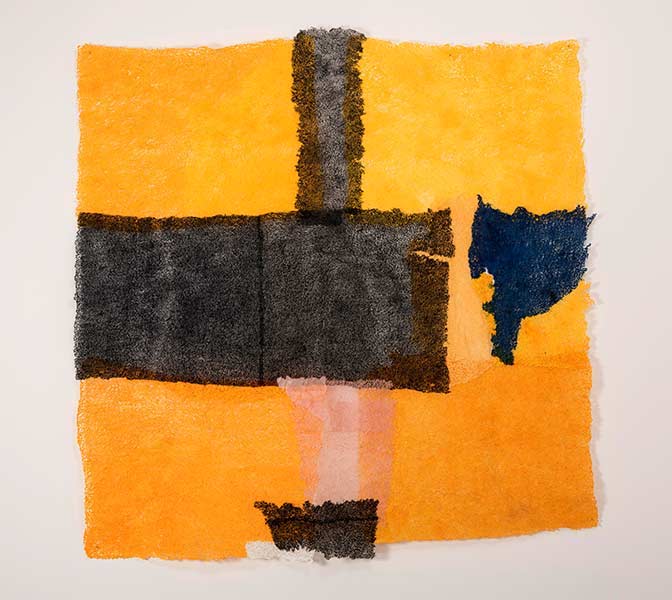Rigor is central to Neha Vedpathak’s artistic practice. At the beginning of her career, between 2004 and 2008, she used to paint at least one painting a day. Now her preferred materials have gone beyond paint and canvas—involving handmade paper, acrylic, polymer, and Plexiglas—productivity and discipline remain at the crux of her practice. In 2009, she wanted to explore making art beyond painting on two-dimensional surfaces and began to experiment with a material that was more agile and accessible: handmade paper. Her search for a disciplined, repetitive form of artmaking led her to begin a manipulating process of white Japanese handmade paper, to transform the two-dimensional object into a relief.
Vedpathak spends hours in the studio, plucking at sheets of handmade paper with a tiny push-pin to separate its fibers. The outcome is a subtly textured surface that resembles white lace. Sometimes she applies color to the surface after it’s been plucked, until the pigments reach the other side. This coloring technique could be likened to that of the Dansakhwa artist, Ha Chong Hyun, who has a similar meditative practice, pushing paint through the back of the canvas to its front. Vedpathak’s practice is laborious and layered. The plucking is both meditative and obsessive.
I visited Vedpathank’s studio a few months ago to learn about her most recent series of plucked works. Her process is almost exclusively inspired by elements that surround her. After living in Chicago for six years, she moved to Arizona for two and half years, where she extracted pigments from local natural sources, like plants and rocks. Although, Vedpathak and her partner lived in Dearborn, Michigan in 2007 (a Detroit suburb) prior to her time in Chicago, it was not until recently that they have decided to stay in Detroit for good, where she has become heavily influenced by the unique cityscape. (They purchased a home in the historic Woodbridge neighborhood, where Vedpathak’s studio is also situated.)
Almost every artist who comes to Detroit finds that it is impossible to not have a reaction to the city’s landscape. Detroit people, its ruins, blight, vastness, and decay are all emblematic of its inimitability. These visceral interactions visitors have with Detroit often leave an indelible mark on its residents, especially those who are new to it. However, in recent years, the city has experienced an influx of media coverage whereby images of bare homes are often exploited by outsiders, creating a hyperbolic portrayal of Detroit as a postapocalyptic wasteland. The city has become a metaphor for destruction, destitution, and, now, a renaissance. These are misnomers. There is no denial that the city is in a state of recovery, but often missing from these vacuous narratives are the people who once called these ruins home, and those who still do.
Vedpathak is conscious of these tensions, of narrative embellishment and erasure. She prides herself on listening—to material, to people, and to place—and she responds. She subsumes the landscape, desiring to conjure and manifest through her work the ephemeral experiences it produces. After a couple of visits to a particular site she finds of interest, she may then photograph it as a reference for her work in her studio. Photographing an environment is never her initial impulse; she prefers to first “be present” in a space.
While in Detroit, Vedpathak has made architectural works, influenced by the range of built structures and empty lots that are subject to demolition. She incorporates scraps from old homes that she has found at architectural-salvage businesses throughout the city, which often include window seals, awnings, and decorative mirrors. In the work See what you don’t see (2016), Vedpathak suggests to the viewer that there is beauty in corrosion, a beauty that is only evident to those who are willing to look beyond the surface. The relatively large, two-dimensional work of pigment on her signature plucked paper invokes hues familiar to many of Detroit’s structures: dark grays, cloudy blues, and accents of red and yellow. In the piece, she has layered the plucked paper to resemble a structure in decay; some areas in the piece appear dense while other areas suggest hollowness.
Defiant (2016), another plucked-paper work that the artist made in response to her encounters with Detroit—and the title of her most recent show at N’Namdi Contemporary Gallery in Miami, Florida—spans approximately sixty inches in length and width. A generous amount of vibrant yellow and orange pigments is distributed across the paper. A small, subtle scrap of plucked paper, painted pink, is at the bottom of the piece. At the work’s center are additional smaller, square, black-colored plucked sheets. Small black rectangular pieces of paper that extend to the top and bottom of the work, intersect deep-blue elements, and create a cross-like form within the work. The black elements are translucent; underneath, it appears as if white pigment, or opaqueness, is trying to saturate the black. The work is a collage and a painting. Its visual vernacular is not unlike cartography, mirroring some notable maps of Detroit that depict, with starkly contrasting colors, the ethnically segregated neighborhoods throughout the city. Vedpathak’s ethnographic clairvoyance of Detroit is evident in Defiant. In this piece, she captures her experience, as a relatively new resident bearing witness to the social, economic, political, and racial tensions that are at play in the city; yet the work presents a cohesion that is made possible by these contrasting tensions. Defiant is an elegy as well as a jubilation.







